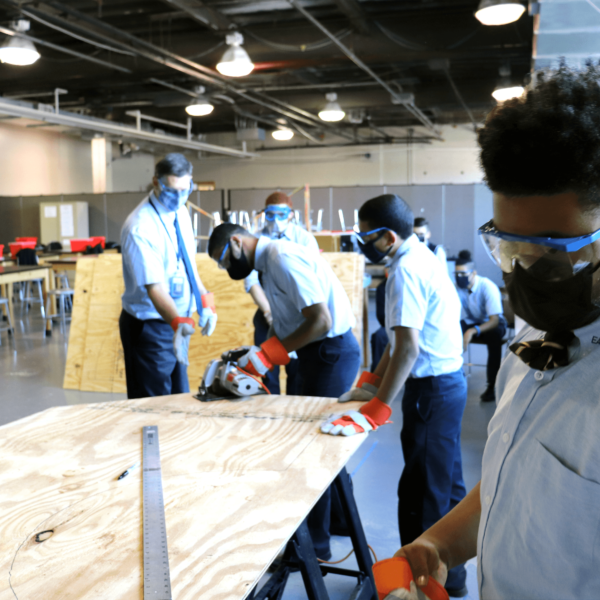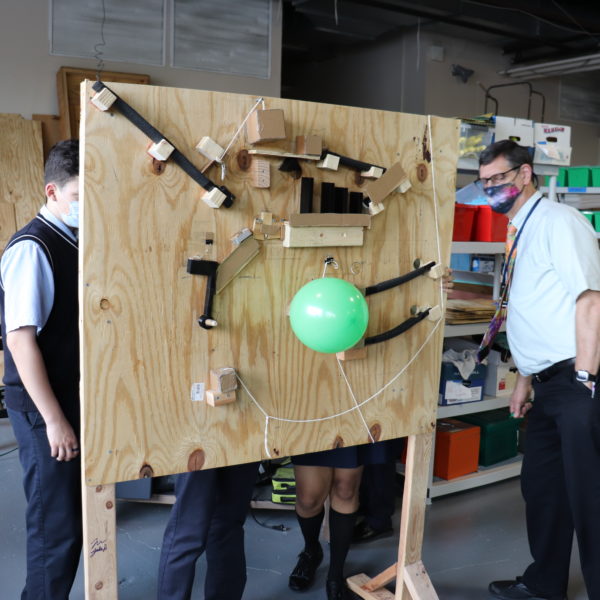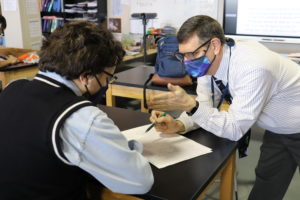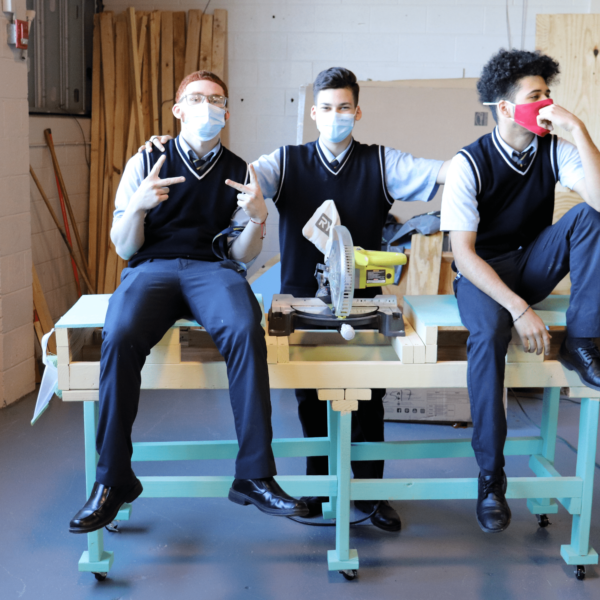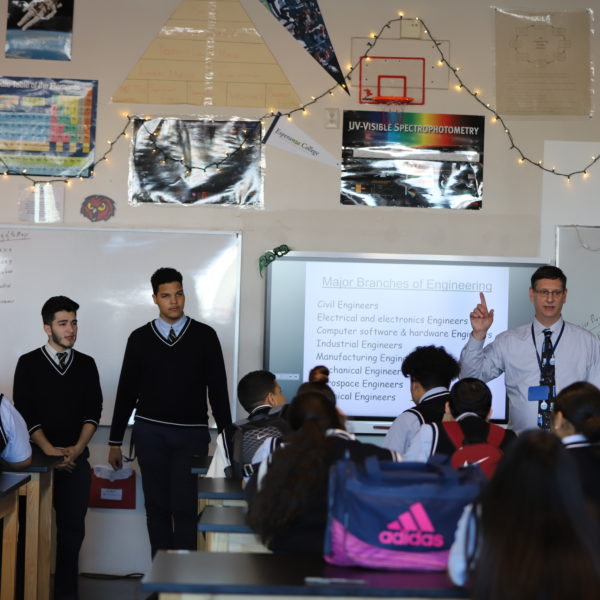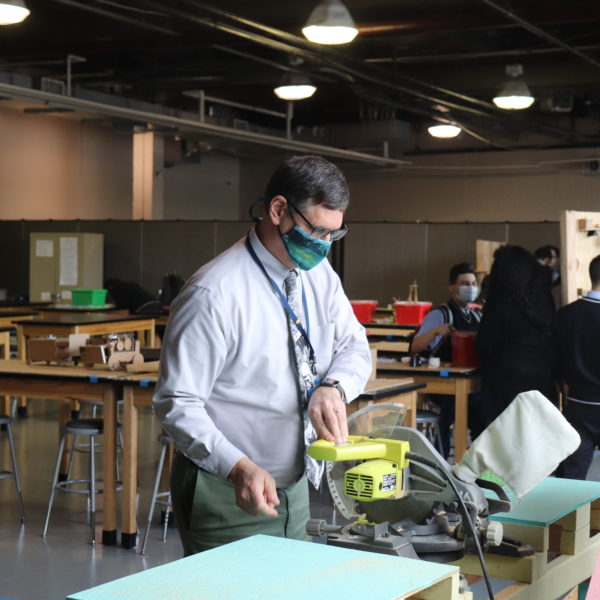1. Favorite part of teaching at Esperanza?
I love teaching physics and engineering. Physics helps students understand how and why things move, and engineering allows students to explore how we can use physics to build something fun. With the Major Program at Esperanza, students can learn about physics and engineering over a period of three years, allowing for in-depth investigation into both. So I love teaching at Esperanza because I have the opportunity to share both of my passions with my students.
2. What inspired you to become an engineer?
When I was in elementary and middle school, I was inclined towards math and science. In high school, I had a design teacher (Mr. Russell) that showed me how to do mechanical drafting, my favorite class. My parents strongly encouraged me to go to college (even though I did not want to go), and so I chose to pursue engineering. Once at college, I realized that I loved learning so I went on to earn several college degrees.
3. What did you do as an Engineer?
The primary purpose of all engineers is to solve problems. Depending on what industry you choose and the amount of experience you have, the problem can be simple (like move the equipment to a new room) or very challenging (like design and build a class 1000 clean room). Engineers use math and science to solve the challenge with the understanding that costs should be minimum. For me, I started in the glass industry working with the manufacturing of molten glass (temperature of 2000 degrees F) into Corelle dinner plates. After a few years, I began working in the plastic industry. My last project in engineering was designing the downstream packaging for the plastic Nutella jar as it was being transitioned from glass to plastic.
4. Why did you become a teacher?
I felt a calling to become a teacher. I found that my love of science was drawing my attention away from engineering, and over several years, I made the decision to switch careers and become a teacher. An interesting fact about the transition was that I made the transition out of engineering with two young children, moving from NJ to Philadelphia to attend graduate school at Temple University. I went from having a comfortable salary and a beautiful home in NJ to living in a tiny apartment with my wife working part time as our source of income. It was a fun and challenging transition that taught me a lot about myself.
5. How long have you been at Esperanza?
I have been teaching for 18 years, the last 9 here at Esperanza.
6. What are some things that your alumni are up to?
I have only kept in contact with a few students that have completed the Engineering Major. Some of my engineering alumni are attending engineering programs at schools such as Temple and Penn State, and some students go on to trade programs, such as automotive maintenance. I do know of a former student that graduated this past May and prior to graduation had already accepted a job with a civil engineering firm in Florida.
7. You had mentioned before the Engineering Design Process, what is that?
The Engineering Design Process is a tool to help students to learn how to systematically solve problems in a step-by-step manner. If students are able to follow the Engineering Design Process, they will minimize problems and maximize their successes.
8. What are some of the projects that students work on?
There are many projects that students work on during their time in the Engineering program. I will highlight a few. For Sophomores in the Introduction to Engineering class, their capstone project for the year involves the design and building of a 60” bridge that functions as a real bridge (students get to choose the type of bridge). The project involves students learning the vocabulary for bridges and how to manage a budget to make sure the bridge is within the stated budget as well as designing and building their bridge. When they are done building, I will test the bridge by hanging 2 kilograms from the center of the bridge. Hopefully it holds. The project takes about two months to complete.
During their junior year, students have many projects to choose from, including designing, building, and testing vehicles experiencing collisions and learning how to utilize power tools such as miter saws and electric drills to build workbenches. This year my juniors are in the process of designing and building a Trebuchet (like a catapult but cooler) that will toss a tennis ball several hundred feet. They will first learn the physics of how a Trebuchet functions and then will design their own device and test it.
For students entering their third year of engineering, there are several choices to make. About half the seniors will choose to take AP Computer Science Principles. Computer Science students are in high demand and can often enter the job market (after four years of college) earning more than $70,000 per year. The other half of the seniors have the opportunity to take a brand new class that will be offered for the first time in the fall. This new class is called Trades Engineering and will allow students to explore the field of carpentry and electricity. My hope is that students that do not want to go to college will now have the opportunity to attend a technical school to learn a trade.
9. Anything else you would like to add? (fun facts, family life, etc.)
Some fun facts about me:
- I have been married for 29 years with two grown children.
- I now have been teaching longer than I was an engineer. I still think of myself first as an engineer, which drives how I think and interact with the world.
- I served in the Army National Guard and often bring examples of my experiences in the Army into the classroom.
- I have two primary ways that I like to relax, gardening in the yard and riding my mountain bike in Penny Pack park.




